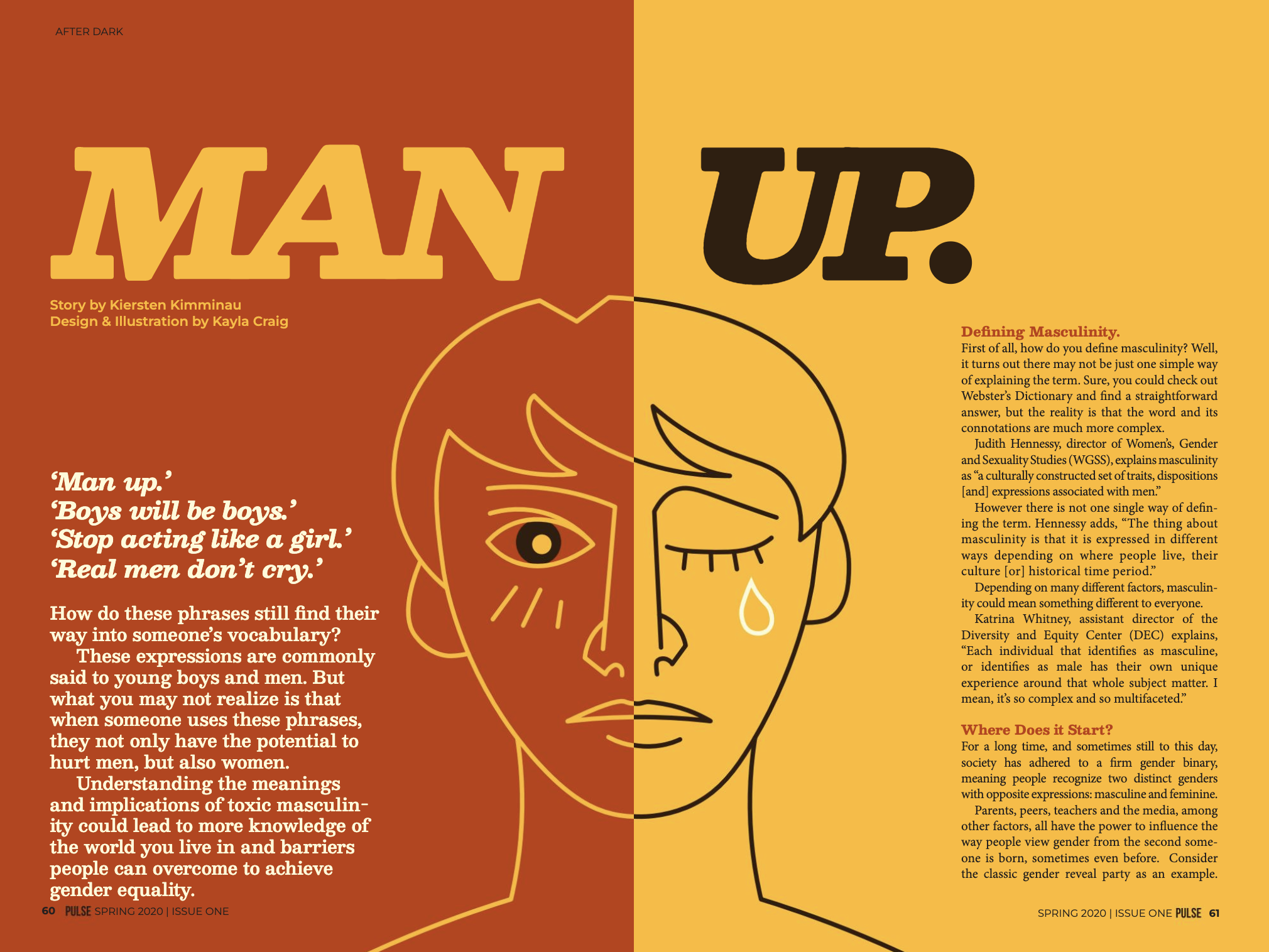Man Up
Story by Kiersten Kimminau | Design & Illustrations by Kayla Kraig
‘Man up.’ ‘Boys will be boys.’ ‘Stop acting like a girl.’ ‘Real men don’t cry.’ How do these phrases still find their way into someone’s vocabulary?
These expressions are commonly said to young boys and men. But what you may not realize is that when someone uses these phrases, they not only have the potential to hurt men, but also women.
Understanding the meanings and implications of toxic masculinity could lead to more knowledge of the world you live in and barriers people can overcome to achieve gender equality.
Defining Masculinity
First of all, how do you define masculinity? Well, it turns out there may not be just one simple way of explaining the term. Sure, you could check out Webster’s Dictionary and find a straightforward answer, but the reality is that the word and its connotations are much more complex.
Judith Hennessy, director of Women’s, Gender and Sexuality Studies (WGSS), explains masculinity as “a culturally constructed set of traits, dispositions [and] expressions associated with men.”
However there is not one single way of defining the term. Hennessy adds, “The thing about masculinity is that it is expressed in different ways depending on where people live, their culture [or] historical time period.”
Depending on many different factors, masculinity could mean something different to everyone.
Katrina Whitney, assistant director of the Diversity and Equity Center (DEC) explains, “Each individual that identifies as masculine, or identifies as male has their own unique experience around that whole subject matter. I mean, it’s so complex and so multifaceted.”
Where Does it Start?
For a long time, and sometimes still to this day, society has adhered to a firm gender binary, meaning people recognize two distinct genders with opposite expressions: masculine and feminine.
Parents, peers, teachers and the media, among other factors, all have the power to influence the way people view gender from the second someone is born, sometimes even before. Consider the classic gender reveal party as an example. “They always have to use blue for the boy [and] pink for the girl. Why?” says Whitney.
Then, once a child is born and they begin to get older, they start figuring out their interests and exploring who they want to be. It is at this crucial stage when expression can either be encouraged or shut down.
Even clothing can be an outlet for personal expression, but those who identify as men may have less freedom in this department.
“I don’t perceive from a masculine perspective that men in our society have the flexibility that I do as feminine identified. I can wear an old pair of jeans and a sweatshirt and not have the same potential comments, stares, looks, whatever the case may be, directed towards me as maybe an individual that identifies as male or masculine going out” in more traditionally feminine clothing, explains Whitney.
Most people may have been taught that men and women need to look and act in a certain way. Destiny Towery, senior Anthropology major, uses nail painting as another example. They say, “I think nail painting is fun. Why can only some people do it?”
People may often be taught that dresses, dolls, nail painting and the color pink are only for girls. But Towery thinks people should “do things they want to do and that they like to do,” regardless of gender.
Exploration & Asking Questions
Erasing the binary concepts of gender is not something that can happen overnight. First, conversations can take place that challenge people’s current ways of thinking, and all it takes is one individual to kick off a conversation.
Towery says that everything starts with an individual and the systems they follow. If there is to be any systemic change in the ways people view gender expression, it may need to start with individuals having the courage to ask questions and start discussions.
The DEC’s mission is to help people along with this by posing questions that challenge individuals to think about their own biases and opinions. “Higher [education] is about exploration,” says Whitney. “The beauty of the human experience is we get to evolve. We don’t have to keep the same thoughts or perspectives that we were raised with.”
According to Whitney, the DEC works with WGSS to explore gender and “provide opportunity for thoughtful discussion and dialogue around identity.”
She adds, “A component of that identity, of course, is our masculine or male identity.”
Introducing Change
Next time you are going through life and having conversations, try paying attention to how your actions and language may perpetuate gender stereotypes.
“Phrases like ‘grow a pair of balls’ or ‘just be a man’ or ‘suck it up’ … are really bad and unhealthy,” says Towery. “They perpetuate situations that are bad for everyone because it doesn’t just affect these men, or these masculine individuals, it also affects the people around them and it creates a ripple effect.”
Gender norms and stereotypes can affect anyone. For this reason, when people talk about the influence of masculinity, they can start by recognizing the impacts on men and women alike.
“Yes, [men] benefit systemically,” says Towery. However, they explain that this does not mean that men aren’t hurting in other ways. Culturally, men and women can both be harmed by uncompromising gender expectations.
Patrick Lemmon, consultant and co-founder of Men Can Stop Rape, expresses a similar sentiment. “I want to be very clear that patriarchy hurts people who aren’t identified as male, much more than it hurts people who are identified as male, but it also really sucks for people who are identified as male. The box is small and tight and it doesn’t fit anybody … no matter what we’re doing, we’re always trying to fit into something that doesn’t fit us.”
According to Towery, people can break out of this limiting box by “including men in feminist conversations,” making sure there are safe spaces for men and women and “making sure that women and feminine identifying people get what they need, [while] also making sure that men get what they need.”
Towery also wants to “make a clear distinction between systems and individuals, [because] we live in a very individualized society.”
This means that just because some people think one way, doesn’t mean that’s how everyone thinks. It may feel like there is pressure to be a certain way, but keep in mind that masculinity and femininity should not be limiting things.
In fact, why do certain qualities even need to be labeled as either masculine or feminine? Hennessy says, “Wouldn’t it be better to think of a range of people with a range of different human characteristics and not assume they were attached to a specific gender?”
She lists qualities such as strength, bravery, compassion, kindness and leadership among other valuable qualities that all humans should be free to express.
Going forward, maybe challenge yourself to go against what it means to ‘act like a man’ or ‘be a lady’, because each individual has the freedom to express themselves however they may choose.







